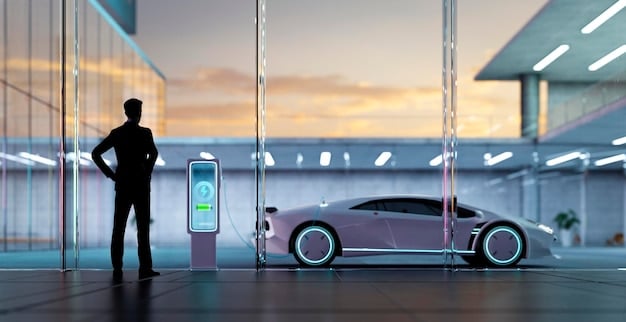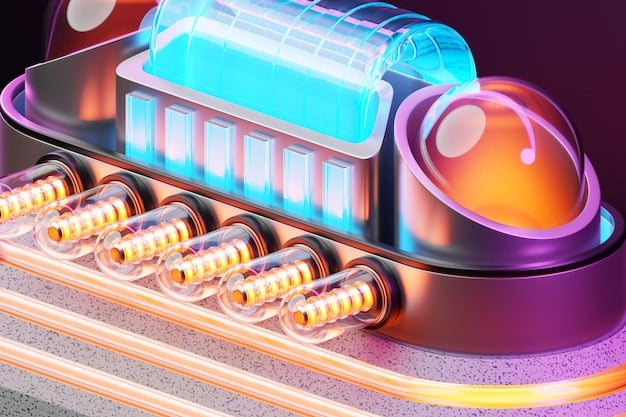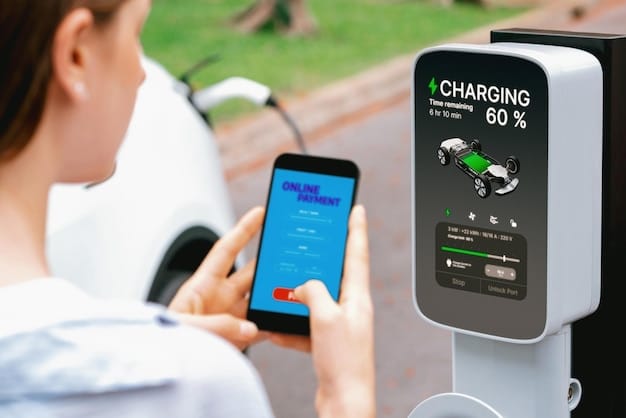The Future of Electric Vehicles in the US: Battery Tech Impact

The future of electric vehicles in the US is inextricably linked to advancements in battery technology. These advancements promise to significantly impact both the range capabilities and charging times of EVs, potentially accelerating their adoption across the country.
The automotive landscape in the US is on the cusp of a revolution, driven by the inexorable rise of electric vehicles (EVs). The key to unlocking the full potential of this transformation lies in the continuous evolution of battery technology, which directly influences the range and charging times of these vehicles. Understanding the future of electric vehicles in the US: how battery technology advancements will impact range and charging times is crucial for consumers, policymakers, and investors alike. Let’s explore how these advancements are shaping the future of American roads.
The Current State of Electric Vehicles in the US
Electric vehicles are no longer a novelty; they are a growing presence on American roads. However, several factors still hinder their widespread adoption. Understanding these challenges is crucial to appreciating the impact of future battery technology advancements.
Current EVs face limitations in terms of range, charging infrastructure, and cost. While the upfront cost of EVs has been decreasing, it remains a barrier for many consumers. Moreover, range anxiety – the fear of running out of battery power – and the limited availability of charging stations continue to be significant concerns.
Major Challenges Facing EV Adoption
Several key challenges must be addressed to accelerate the adoption of EVs in the US. These include:
- Range Limitations: Many current EVs offer a range of 200-300 miles, which may not be sufficient for longer trips or for those living in rural areas.
- Charging Time: Charging an EV can take significantly longer than filling up a gasoline-powered vehicle, especially with standard charging methods.
- Infrastructure: The availability of public charging stations is still limited in many parts of the country, making it difficult for EV owners to charge their vehicles on the go.
- Cost: While EV prices are falling, they are still generally higher than comparable gasoline-powered vehicles, although government incentives can help offset this difference.
Addressing these challenges through technological advancements, policy support, and infrastructure development is essential for fostering a sustainable and widespread transition to electric mobility in the United States.
Innovations in Battery Technology
The future of electric vehicles hinges on breakthroughs in battery technology. Several promising innovations are currently under development and are poised to revolutionize the EV landscape.
These innovations aim to improve energy density, charging speed, safety, and cost. From solid-state batteries to lithium-sulfur and silicon anode technologies, the potential impact of these advancements is immense.

Key Battery Technologies to Watch
- Solid-State Batteries: These batteries replace the liquid electrolyte with a solid material, offering higher energy density, improved safety, and faster charging times.
- Lithium-Sulfur Batteries: These batteries use sulfur as the cathode material, which is more abundant and less expensive than the materials used in traditional lithium-ion batteries, potentially leading to lower costs and higher energy density.
- Silicon Anode Batteries: Replacing graphite with silicon in the anode can significantly increase the battery’s energy storage capacity, as silicon can store more lithium ions.
These technologies represent the cutting edge of battery research and development and promise to overcome many of the limitations of current EV batteries.
Impact on EV Range
One of the most significant benefits of advanced battery technology is the potential to dramatically increase the range of electric vehicles. This will alleviate range anxiety and make EVs a more practical option for a wider range of drivers.
The implementation of these advanced technologies could lead to EVs with ranges exceeding 500 miles on a single charge. This improvement would make EVs competitive with gasoline-powered vehicles in terms of range, removing a major barrier to adoption.
Projections for Future EV Range
The impact of these technologies on EV range can be quantified through projections and forecasts. Consider the following:
- Near-Term (2025-2027): Expect improvements in existing lithium-ion technology to push average EV ranges to 350-450 miles.
- Mid-Term (2028-2030): The introduction of solid-state batteries could enable EVs with ranges of 450-600 miles.
- Long-Term (Beyond 2030): Lithium-sulfur and other advanced technologies could lead to EVs capable of traveling over 600 miles on a single charge.
These projections highlight the significant potential for battery technology to transform the EV landscape and make electric vehicles a more viable option for all drivers.
Reducing Charging Times
Equally important to increasing range is reducing charging times. Faster charging speeds will make EVs more convenient and competitive with gasoline-powered vehicles.
Advanced battery technologies, combined with improved charging infrastructure, are crucial to achieving this goal. The development of high-power charging stations and more efficient battery designs will drastically reduce the time it takes to recharge an EV.
Advancements in Charging Infrastructure
Beyond battery technology, advancements in charging infrastructure are equally critical in reducing charging times. Key areas of focus include:
- High-Power Charging Stations: The deployment of 350kW+ charging stations can significantly reduce charging times, allowing EVs to gain hundreds of miles of range in a matter of minutes.
- Smart Charging Systems: These systems optimize charging schedules based on grid load and energy prices, helping to reduce costs and improve grid stability.
- Wireless Charging: Wireless charging technology offers a convenient and seamless way to charge EVs, both at home and in public spaces.
By combining advanced battery technologies with improved charging infrastructure, the EV industry can address one of the primary concerns of potential EV buyers: the time it takes to recharge their vehicles.

The Role of Government and Policy
Government policies and incentives play a crucial role in accelerating the adoption of electric vehicles and promoting the development of advanced battery technologies. Supportive policies can create a favorable environment for both consumers and manufacturers.
Incentives such as tax credits, rebates, and subsidies can help reduce the upfront cost of EVs, making them more accessible to a wider range of consumers. Additionally, government funding for research and development can drive innovation in battery technology and charging infrastructure.
Key Policy Measures Supporting EV Adoption
Several policy measures can significantly impact the adoption of EVs in the US. These include:
- Tax Credits and Rebates: Federal and state tax credits can help offset the cost of purchasing an EV.
- Infrastructure Investments: Government funding for the deployment of public charging stations can address range anxiety and make EVs more convenient.
- Emissions Standards: Stringent emissions standards for gasoline-powered vehicles can incentivize manufacturers to invest in electric vehicle technology.
These policies, combined with consumer education and awareness campaigns, can help drive the transition to electric mobility and create a more sustainable transportation system.
The Future Outlook
The future of electric vehicles in the US is bright, with ongoing advancements in battery technology promising to overcome many of the current limitations. As these technologies mature and become more affordable, EVs are poised to become the dominant form of transportation.
The convergence of improved battery performance, faster charging speeds, and supportive government policies will create a tipping point, accelerating the mass adoption of EVs. This transition will have profound implications for the environment, the economy, and the automotive industry.
| Key Point | Brief Description |
|---|---|
| ⚡️ Battery Tech | Advancements like solid-state improve range & charging. |
| 🛣️ Range Increase | Future EVs may exceed 500 miles per charge. |
| ⏱️ Charging Time | High-power stations and smart systems reduce recharge times. |
| 🏛️ Government Role | Incentives and infrastructure funding drive EV adoption. |
FAQ
▼
Solid-state batteries replace the liquid electrolyte found in conventional lithium-ion batteries with a solid material. This results in higher energy density, improved safety, and potentially faster charging times.
▼
Advanced charging infrastructure, such as high-power charging stations, will significantly reduce charging times. Smart charging systems can also optimize energy usage, making EV charging more efficient and cost-effective.
▼
Governments can incentivize EV adoption through tax credits, rebates, and funding for charging infrastructure. They can also set emissions standards that encourage manufacturers to invest in electric vehicle technology.
▼
“Range anxiety” is the fear that an electric vehicle will run out of battery power before reaching a charging station. This can be mitigated by increasing EV range and expanding the availability of public charging stations.
▼
While it’s hard to pinpoint an exact date, solid-state batteries and other advancements are expected to become more prevalent in EVs by the late 2020s, further driving down costs and boosting performance.
Conclusion
The advancements in battery technology promise a transformative future for electric vehicles in the US, significantly boosting range and slashing charging times. As these innovations mature and governmental support solidifies, EVs are poised to dominate the transportation landscape, offering a sustainable and efficient alternative to traditional gasoline vehicles.





